On a sunny spring day, 25-year-old Americorps member Mandi Johnson cracked open the lid to a big tub outside the Port Townsend Marine Science Center Museum. She reeled back for a second, after getting a whiff of the stench.
This item is available in full to subscribers.
We have recently launched a new and improved website. To continue reading, you will need to either log into your subscriber account, or purchase a new subscription.
If you had an active account on our previous website, then you have an account here. Simply reset your password to regain access to your account.
If you did not have an account on our previous website, but are a current print subscriber, click here to set up your website account.
Otherwise, click here to view your options for subscribing.
* Having trouble? Call our circulation department at 360-385-2900, or email our support.
Please log in to continue |
|
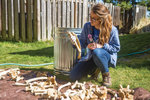
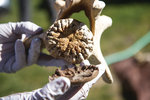
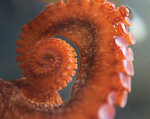
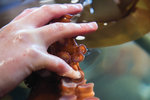
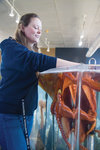
On a sunny spring day, 25-year-old Americorps member Mandi Johnson cracked open the lid to a big tub outside the Port Townsend Marine Science Center Museum.
She reeled back for a second, after getting a whiff of the stench.
“It’s not going to smell good, just a warning,” she said.
Inside the tub was a pile of bones. No, not human ones. Seal bones.
An elephant seal, the largest of pinnipeds in the Pacific Northwest washed up on Marrowstone Island on Halloween. At the time, Johnson was fresh in her new role as the Americorps member assigned to helping with marine mammal strandings. The prospect of a dead elephant seal, though a bit heartbreaking, was also exciting for this young biologist.
“It’s not very common for a mammal this large to wash up in tact,” Johnson said.
With permission from National Oceanic and Atmospheric Administration, the Port Townsend Marine Science Center is preserving the bones of the elephant seal for marine education in their museum at Fort Worden.
But the process of getting a dead seal from the beach into a preserved state at a museum is not an easy job.
Armed with a toothbrush, a garden hose and a large tarp, Johnson began laying each bone out on the tarp to be rinsed and scrubbed, with help from Betsy Carlson, the Citizen Scientist Coordinator at the Port Townsend Marine Science Center.
The first step in the process was to do a necropsy, an autopsy for animals, to see what went wrong with the elephant seal.
“From there you do a filencium procedure, which is essentially cutting off all the blubber and the stuff we don’t need, and then cutting it into parts,” Johnson said.
The flippers get cut off, the spine and the skull gets taken apart. Then, the remains hung off of the Marine Science Center’s pier for several months. In the water, the flesh could decompose naturally.
“We pulled up the spine with all the ribs and it was mostly decomposed,” Johnson said. “Then, we boiled the bones.”
They looked a bit like witches, Johnson said, as they boiled the bones in large pots of water. Next, the bones were soaked in water to de-grease them. And now, as Johnson laid them out on the tarp in the sun, it was time for a final scrub before they dried them out.
While the seal will eventually get put back together piece by piece, the process of doing a necropsy is an important research tool.
The data that the Marine Science Center collects will go directly to NOAA, as part of their national Marine Mammal Stranding Network program. Members of the network respond to marine mammal strandings, of both alive and dead animals, along the Washington, Oregon, and California coasts and are part of a nationwide network of data collection.
“The health of these animals is essentially the health of the Salish Sea,” Johnson said. “If we’re seeing a lot of a certain species stranding, maybe it’s not just in one area but overall along the coast of Washington, we can notice if there is a trend or something happening with that.”
Right now, researchers are looking for antibiotic resistant bacteria in mammals.
“You can think of them as indicators of the water quality,” Carlson said. “Afterall, they are floating in it all the time.”
They also search the bodies of dead animals, like the elephant seal, for any marks indicating human interaction, such as getting caught in nets, fishery equipment or getting shot. Last fall, about 19 California sea lions were shot, Carlson said.
“The Marine Mammal Stranding Network is also just a good community service as well,” Carlson said. “The Department of Fish and Wildlife doesn’t have people to come out and sit with a seal pup. But we can train volunteers to come and basically keep humans away from seal pups, or anything that is still alive and on the beach.”
For Johnson, being involved in marine animals, specifically stranding, is what she hopes to do in the future. Taking the Americorps job at the Marine Science Center was an opportunity for Johnson, who is from Arizona, to get hands on experience in the marine mammal world.
Not only does she get to help with the marine mammal stranding network, but she gets to assist other Americorps interns with their duties in the aquarium and organizing volunteer events.
“If I could continue with marine science, that was the goal,” she said. “And this is the place to do it. I’ve learned a lot.”
FEEDING THE FISH
Meanwhile, over in the aquarium, Johnson’s fellow Americorps intern Marley Loomis, age 23, does not have to dip her hands into a bin full of seal bones. But she does have to dip her hands into a tank with a live octopus.
And though Eleanora the Giant Pacific octopus, who has been at the Marine Science Center since last fall, is friendly, the speed at which she snatches up a crab to eat for a snack means that trust is involved in their relationship.
“It’s pretty phenomenal to have some mutual trust with an octopus,” Loomis said. “It has definitely added a fun unexpected element to this job.”
Loomis’ Americorps duties have her working with Ali Redman, the aquarist at the Center, on animal husbandry, animal care, and aquarium education.
While the aquarium was closed to the public in the winter hours, Loomis, Redman and numerous volunteers were still hard at work, taking care of the animals and brainstorming about the future of the aquarium.
Part of her duties include the nitty gritty stuff: scrubbing tanks clean, stocking tubs full of fresh seaweed, and getting fish out of the freezer to feed the octopus.
“I smell like fish by the time I leave here every day,” Loomis said. “I have what I call my ‘aquarium jacket.’”
But there is more to the aquarium than feeding the fish. There is a delicate balance between making the aquarium a healthy place for the animals, while also making it a place of education for visitors.
“We want to make sure our animals are happy,” Loomis said. “We’ve been trying to brainstorm and think about the most educational and engaging layouts for the aquarium, that are also best for the animals.”
There are between 90 and 100 different species in the aquarium, separated into different tanks. Some are tide pools where kids and adults alike can reach in and touch the anemones, starfish and tube worms inside. Others are tanks of underwater seaweed gardens, filled with fish and crabs that hide in the greens.
For Loomis, who is from Colorado and studied ecology and evolutionary biology, this is her first job working directly with marine animals and it took time to learn all their names. The aquarium also pumps in water directly from the Salish Sea for the tanks, which means that new animals sneak in through the pipes all the time.
Once she mastered that, she learned their eating habits, their personalities, and what they need to be the most healthy.
Animal husbandry is typically a term used for those who care for livestock and cattle. But at the aquarium Loomis and Redman work on husbandry with animals that seem like they might not have huge personalities, but they do.
For example, the abalone only like to eat the very best looking seaweed. Eleanora the octopus likes to play with her food, in puzzles or small toy boats. Not to mention, that when Loomis leaves the aquarium at the end of the day, she has to make sure none of the critters (namely the octopus) will escape.
“I do like four mental checks before I walk out,” she said.
Beyond learning to care for the animals, Loomis also has to be able to care for the human visitors who come in to the aquarium.
“Sometimes people ask questions that I don’t necessarily have the answer to,” she said.
As she continues down her path of marine education, Loomis said she hopes to continue working at the marine science center in the future.
“There’s such a grand list of projects when you first start the Americorps job,” she said. “At a place like this, that is so dynamic, that list is always changing. I’d like to continue to make the aquarium more accessible and more interpretive down the road.”